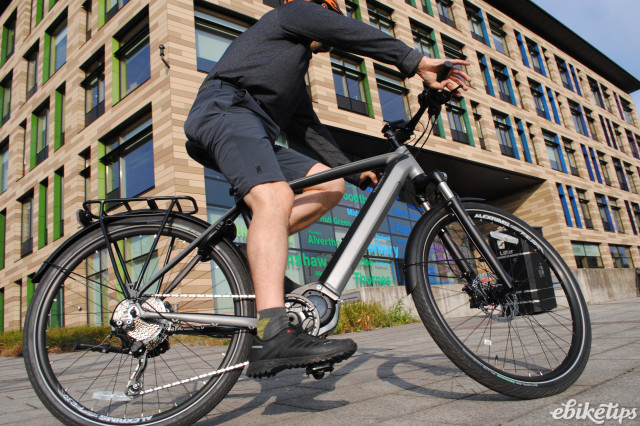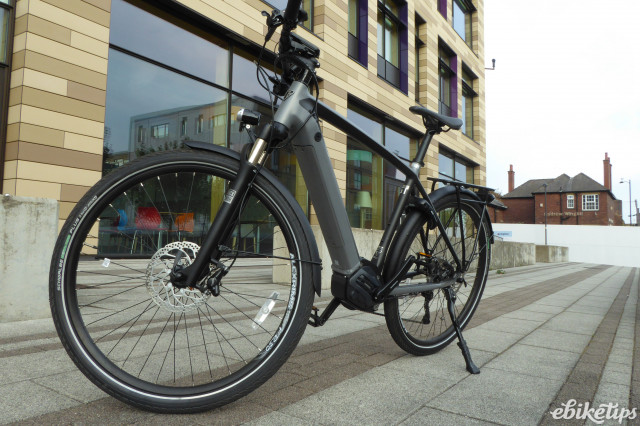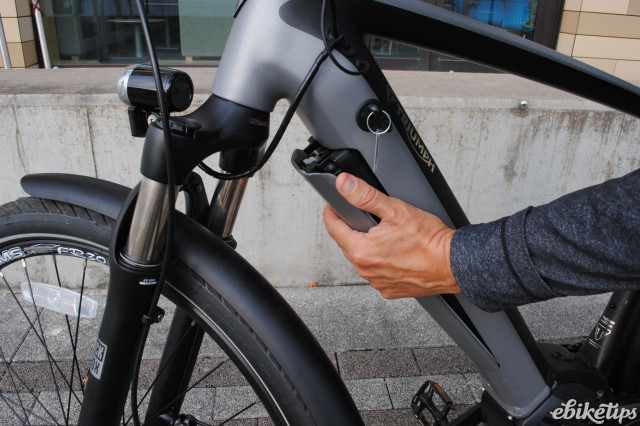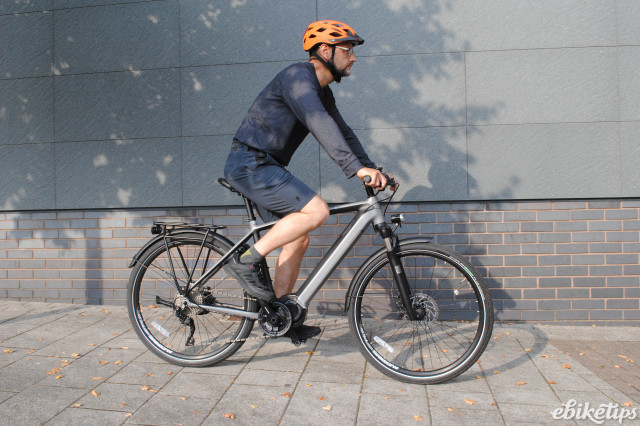Triumph Trekker GT

Overview
- Lovely design
- Great motor system
- Bigger battery, air suspension and USB charging would make it better value
Like many venerable UK manufacturing names, Triumph has had a turbulent recent history. From Victorian foundations as a bicycle manufacturer, it transitioned into making famously reliable motorbikes, then became one the UK’s major motorbike and car manufacturers in the 1920s before selling the Triumph bicycle business to Raleigh in 1932.
Buy the Triumph Trekker GT Here
The 1940s and 1950s saw Triumph rise from the ashes of a bombed factory and go on to export large numbers of motorbikes to the US. A victim of Japanese competition, the company became bankrupt in 1983, but marketing and name rights were purchased which allowed production to be relaunched from Hinckley.
Triumph are now looking for continued success with the launch of the Triumph Trekker e-bike. It certainly looks a sleek and sporty design for commuting and leisure use, and notably features Shimano’s latest mid-motor system, the E6100. Back in May 2019, ebiketips covered the launch of the E6100 and, comparing it to the motor it succeeded, described it as “smaller, lighter, quieter, more efficient and better looking”. Basically it’s better in every way, and is a solid contender to challenge the new Bosch Active Line motors that were a real leap forward for city bikes.
On paper, Triumph’s first foray into the e-bike world certainly looks good... but will it impress when we put it through its paces?
Complete Commuting Package
What really catches the eye is the Trekker’s very high quality, largely hydroformed frame; the only noticeable weld join is around the mid-drive housing area, and at the end of the rear dropouts. It has internal cable routing and a complete set of commuting features, including a sturdy pannier rack, kickstand, LED lights and mudguards. You get Schwalbe Energizer Plus 27.5 x 2” (50-584) tyres, that fit in with this blend of sporty handling, and have practical features such as 3mm of Greenguard puncture protection with plenty of width for increased comfort.
On the subject of comfort, the RockShox Paragon Silver suspension forks with 65mm of travel is certainly one of the better coil-sprung suspension units out there; though on a bike at the price point, I would be looking for air suspension (the RockShox Paragon Gold, for example). Narrow, flat profile bars and a stem with only 7 degrees of rise promote a sporty riding position, however.
There is a petty wide gearing range (327%) courtesy of ten derailleur gears, with a Shimano Deore Shadow Plus long cage 38T chainring and an 11-36T rear gear cluster. There should be plenty of braking power on tap too from Shimano’s M600 hydraulic system, with a 180mm rotor on the front and 160mm at the rear.
It’s pretty lightweight, given the full accessory package and reasonable sized battery, coming in on our scales at 24.23 kg. This includes a 3.1kg battery, and even a frame lock. Light weight is of course good news, not just for sporty handling but also for manhandling the bike when you’re not riding it.
On the Road
Our first impressions are confirmed: the Trekker GT has a fast riding position with quick sporty handling, smooth quick gear changing and great stopping power. The decent quality coil suspension plus 2” wide tyres gives a plush and comfortable ride too, and are more than adequate for anything your average UK city can throw at it. It would handle unsurfaced traffic-free trail style riding easily too, widening the bike’s horizons.
It’s worth focussing on the new motor performance in particular. Visually sleek and compact, it claims to weigh only 2.88kg and to be 20% more energy efficient than its predecessor, the E6000.
Don’t be fooled by the relatively modest torque rating of 60 Nm (higher performing motors have significantly higher ratings) as it clearly rewarded a bit of rider effort up the hills with plenty of motor power.
Using the high power setting on my regular mile-long hill climb gave performance figures roughly in line with the best mid-drives; in other words, higher performance motors are only really needed for riding that requires a real step-up in performance such as mountain biking, or regularly towing heavy loads up steeper hills. On a shorter 1 in 3 hill test, the E6100 also matched the best mid-drives. These lower specced motors may need a bit more human input than their higher specced cousins but they achieve much the same thing in most riding circumstances.
The torque sensing on the Shimano E6100 is great and responds well to heavy pressure, and not so much to light pressure and high cadence (other systems do). Personally I like it that way around as I usually want the power when I step on the pedals hard, not when spinning along under easier conditions.
Equally, a really pleasant surprise was how easy it was to ride with the power off. I could trundle along on the flat without any headwind at 15-20mph fairly comfortably, and the transition between power and no power at 15mph was pretty smooth, at the lower power levels at least. Hit a slight headwind or gradient and clicking into eco lets you breeze through these obstacles, with normal and high reserved for tougher challenges.
The toggle button by your left thumb is very ergonomically efficient, with raised surfaces at the outer edges so you can easily press the button when needed quickly and accurately, even with gloves on.
The allied central LCD display is one of the larger ones out there, especially when compared to Bosch’s LCD offerings, the Purion and the Intuiva. It’s narrow, long shape and central mounting keeps the bars pretty clutter free and the advantage of its portrait format is that it can list all three range estimates at once (showing projected ranges on Eco, Normal and High settings), which I found pretty handy. There are also odometer, trip distance, cadence, average speed and maximum speed screen displays to toggle through plus regular screen fixtures of clock, speedometer, power delivery meter and battery capacity graphic divided into 20% increments (blocks of five).
Talking of range estimates, I found the computer-generated efforts to be pretty accurate for my 68kg frame. The first of five bars on the display (at 20% capacity per bar) went down after 15 miles of pretty easy riding, suggesting a range of 75 miles over gently rolling terrain, toggling between off, eco and normal power level settings with no real need for the high setting.
Areas for improvement
Triumph’s Trekker is a real looker and a sporty performer. Perhaps Triumph have missed a few opportunities here, or perhaps the chance to feature some ‘extras’ in an upgraded option. A city orientated e-bike like this would have been a great opportunity to try out Shimano’s 5 speed hub gear unit, designed specifically to go with Shimano mid-drives. Its 263% gear range is less than offered by the Deore derailleur setup - and it would no doubt add a bit of weight – but the wide gear steps on hub gears work particularly well with motor power, and are a great ‘fit and forget’ option.
Triumph also seem to have overlooked the option of a larger 630Wh in-frame battery, which was announced fairly recently (perhaps too late for this particular model). In any case, this would have turned what is a capable city and leisure bike into a sporty all-day touring machine, especially as it comes ready to go with a rack, lights and kickstand. Personally I also much prefer frame-integrated batteries that lift out of the top of the downtube, rather than drop out of the bottom as the Triumph design does. The latter option means the battery can catch on the top of the forks, and is just all-round fiddlier to get in and out of the frame in my opinion.
Thru-axles and a heavier rated rack would also have reinforced its credentials as a tough performer in a wide variety of conditions. A USB C port could have been added to enable you to charge devices on the go.
Lastly, as a premium brand using a premium motor system it might have been a good opportunity to try out the Bluetooth and/or Ant+ connectivity options of the E6100 system; but Triumph haven’t gone down this route on their first e-bike. This might be for good reason it’s still a developing area, and I get the feeling, based on bikes I have reviewed so far, that really good hardware and software options that marry together well are only just now beginning to fulfil their undoubted potential. And, of course, such options would most likely have just added to the cost.
Summary
Perhaps a ‘plus version’ with all these extra features I’ve suggested might have proved popular, but despite these quibbles this is a great first e-bike from Triumph, and one that continues a great British two-wheeled tradition into the realm of e-bikes.














